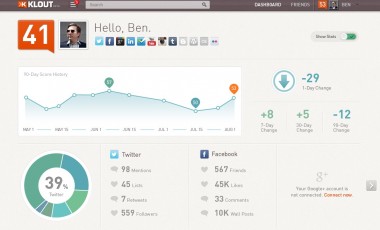Klout Revises Its Algorithm — But Fear Not, It Says Most Scores Will Go Up
Klout today launches what it is describing as a major revamp to its algorithm, adding far more social signals and nuance to its measurement of online influence.
 Klout is a controversial company, in part because it values people’s online activity with a score — but also because: 1) to many, that score did not seem terrifically accurate; and 2) the way the score was determined was not transparent.
Klout is a controversial company, in part because it values people’s online activity with a score — but also because: 1) to many, that score did not seem terrifically accurate; and 2) the way the score was determined was not transparent.The San Francisco-based company obviously isn’t backing away from the whole premise of scoring, but it is improving its efforts to be accurate as well as transparent, by telling the stories behind the scores.
Where Klout looked at fewer than 100 signals before, now it tracks about 400, including the number of Twitter lists a person is on, the number of people who’ve subscribed to them on Facebook, and how important they are on Wikipedia, as determined by a PageRank algorithm.
The company is also, for the first time, factoring in the “+K” its users can give each other as a sort of nomination for influence on a simple topic. But Klout was careful to tell me that this signal is capped to avoid abuse.
One of the criticisms of Klout had been that it seemed to have a skewed view of the world, where, for instance, Justin Bieber was the ultimate — he had a Klout score of 100 — and Barack Obama was hovering down at 94 (he used to be even lower, below tech pundit Robert Scoble). Klout noted that with the addition of Wikipedia edits and other factors, the two have flip-flopped: Bieber is now a 92, and Obama is a 99. Scoble is an 86.
 Previous Klout changes had sparked anger at the company by driving many people’s scores down. A spokeswoman for Klout said she expected the opposite this time, as many people’s influence ranking will go up as additional signals are included. If true, I imagine that spoonful of sugar will make these changes go down more easily.
Previous Klout changes had sparked anger at the company by driving many people’s scores down. A spokeswoman for Klout said she expected the opposite this time, as many people’s influence ranking will go up as additional signals are included. If true, I imagine that spoonful of sugar will make these changes go down more easily.Also, in the coming weeks, Klout said, its scores will get somewhat more transparent. While the company won’t give away the particulars of its algorithm, it will show users a much more visual timeline of moments at which they were most influential.
The new timeline comes with awkward-funny labels such as, “You engaged Joe Fernandez and 18 others in this moment,” as you can see at left.
